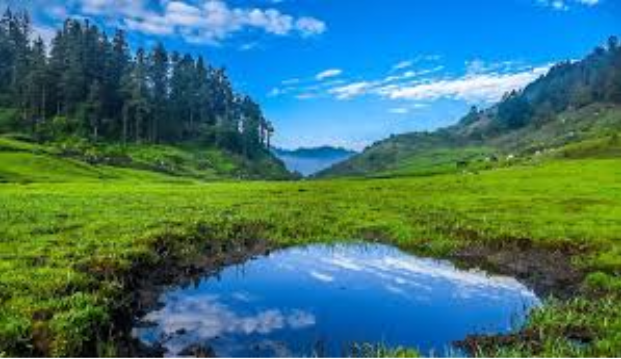Khaptad National Park is one of Nepal’s most unique and serene trekking destinations. Located in the far western part of the country, it offers trekkers an incredible blend of rich biodiversity, pristine nature, and cultural significance. The trek to Khaptad National Park is an adventure for those who seek solitude, beautiful landscapes, and a glimpse into the traditions of remote communities. In this article, we will delve into the various aspects of the Khaptad National Park Trek, including the route, attractions, wildlife, and essential tips for travelers.
Overview of Khaptad National Park
Khaptad National Park, covering an area of 1,742 square kilometers, is situated in the far-western region of Nepal. It was established in 1984 and is named after the famous Khaptad Baba, a spiritual figure who meditated in the area for many years. The park’s diverse ecosystems range from subtropical forests to alpine meadows, offering trekkers a unique opportunity to explore various landscapes and habitats. The trek provides an enriching experience, with lush forests, high-altitude meadows, stunning waterfalls, and panoramic mountain views.
The park is also culturally significant, as it is home to various ethnic groups, including the Tharu, Magar, and Chhetri communities. The trek is not just about natural beauty but also about experiencing the lifestyle and customs of the people living in this remote area of Nepal.
The Khaptad National Park Trek Route
The Khaptad Trek is moderately challenging and is best suited for those who have some trekking experience. The trek typically begins in the town of Dhangadhi, located in the Far Western Development Region of Nepal. From Dhangadhi, trekkers travel by road to the village of Bedkot, which is the starting point for the trek.
The trek usually takes around 7 to 10 days, depending on the pace and route variations. Here is a breakdown of the key sections of the trek:
- Dhangadhi to Bedkot: The journey starts with a scenic drive from Dhangadhi to Bedkot. This is where the trek begins, and the terrain slowly starts to climb as trekkers make their way to the park’s entrance.
- Bedkot to Khaptad: From Bedkot, the trek gradually ascends through dense forests, passing by several small villages and agricultural lands. The trail winds its way upward, offering breathtaking views of the surrounding hills and valleys. As you enter the park, the environment changes to dense subtropical forest, home to various species of flora and fauna.
- Khaptad to Khaptad Baba Ashram: After reaching Khaptad, trekkers visit the Khaptad Baba Ashram, which is located in a peaceful meadow surrounded by the tranquil forest. This place is known for its spiritual significance and is considered a retreat for meditation. Many trekkers visit the ashram to relax, meditate, and reflect in the serene surroundings.
- Khaptad to the High Altitude Meadows: As you continue the trek, you ascend higher into the alpine meadows. These high-altitude areas offer panoramic views of the snow-capped peaks of the Himalayas, including the Api Himal, Saipal, and other nearby mountains. The meadows are perfect for camping, and trekkers can spend a night under the stars, surrounded by breathtaking views.
- Khaptad to the End Point: After exploring the park and its many attractions, trekkers return to Bedkot and then take a vehicle back to Dhangadhi. The trek ends here, but the memories of the pristine natural beauty and cultural experiences linger long after.
Attractions Along the Khaptad Trek
Khaptad National Park is home to a variety of natural and cultural attractions that make the trek truly special. Here are some highlights of the trek:
- Biodiversity: The park is a haven for biodiversity, with over 200 species of birds, 20 species of mammals, and numerous species of plants and trees. Wildlife sightings include the endangered red panda, Himalayan black bear, and the barking deer. The park is also home to several medicinal plants used by local communities for traditional healing practices.
- Khaptad Baba Ashram: The Khaptad Baba Ashram is a key stop on the trek. This peaceful retreat, located at an altitude of 3,000 meters, offers a glimpse into the life of Khaptad Baba, a spiritual leader who spent years meditating in this area. The ashram is surrounded by lush forests and provides a tranquil atmosphere for reflection and spiritual growth.
- High Altitude Meadows: The alpine meadows in the park are known for their stunning beauty, especially during the spring and summer months when wildflowers bloom in full glory. These meadows offer panoramic views of the nearby mountain ranges, making it a perfect spot for photography and nature walks.
- Saipal and Api Himal Views: The trek offers excellent views of the Api Himal and Saipal peaks. These snow-covered mountains provide a dramatic backdrop as you hike through the park, with clear skies and crisp air offering the best conditions for mountain photography.
- Traditional Villages: Along the trek, you will pass through small villages that offer a chance to experience local life. The people of these villages maintain traditional farming practices, and visitors can learn about the region’s customs, food, and way of life.
Wildlife in Khaptad National Park
Khaptad National Park is one of the most biodiverse areas in Nepal. It is home to various species of animals, birds, and plants. Some notable wildlife in the park includes:
- Red Panda: The elusive red panda is one of the rarest and most sought-after animals in the park. While sightings are rare, trekkers who are lucky may catch a glimpse of this endangered species.
- Himalayan Black Bear: The park is home to the Himalayan black bear, which can be spotted in the dense forested areas.
- Barking Deer: Another common mammal in the park is the barking deer, known for its distinct vocalization.
- Birdwatching: Khaptad National Park is a paradise for birdwatchers, with species like the Himalayan monal, blood pheasant, and golden eagle frequently spotted.
Best Time to Trek Khaptad National Park
The best time to undertake the Khaptad Trek is during the spring (March to May) and autumn (September to November). These seasons offer clear skies, pleasant temperatures, and the best conditions for trekking. The monsoon season (June to August) is not ideal due to the heavy rains, which make the trails slippery and challenging. Winter (December to February) can also be a good time if you are prepared for cold temperatures, though higher altitudes may have snow.
Essential Tips for the Trek
- Physical Preparation: While the Khaptad Trek is moderate in difficulty, it’s still important to be physically fit. Regular cardiovascular exercises, like walking or running, will help prepare your body for the trek.
- Pack Light: You’ll be trekking through varying terrains and altitudes, so pack light but include essentials such as a good pair of trekking shoes, warm clothes, a rain jacket, and a first aid kit.
- Hiring a Guide: Hiring a local guide is recommended, especially if you are unfamiliar with the region. A guide will help you navigate the trails, understand the local culture, and enhance your overall experience.
- Respect Local Culture: The local communities in the area follow traditional customs and beliefs. Be respectful of their culture, and always ask for permission before taking photographs of people or their homes.
- Stay Hydrated: High altitudes can cause dehydration, so make sure to carry enough water and drink regularly throughout the trek.
Conclusion
The Khaptad National Park Trek is a perfect blend of nature, adventure, and spirituality. Whether you are a seasoned trekker looking for a new challenge or someone interested in exploring Nepal’s rich cultural heritage, this trek offers something for everyone. From the stunning views of the Saipal and Api Himal to the peaceful meadows and forests, Khaptad National Park is a hidden gem waiting to be explored. Embrace the journey and experience the beauty of one of Nepal’s most untouched trekking destinations.

